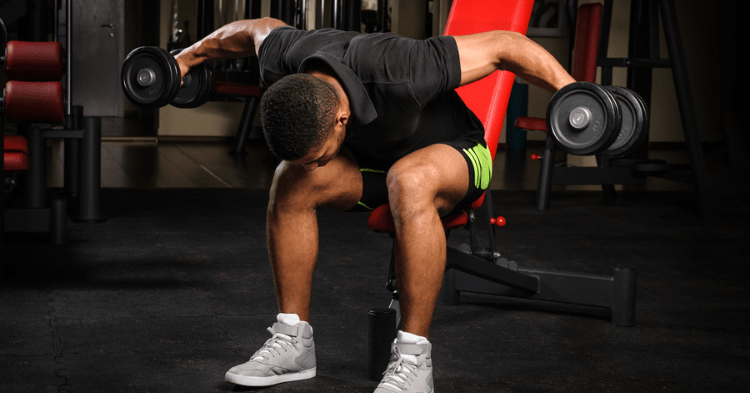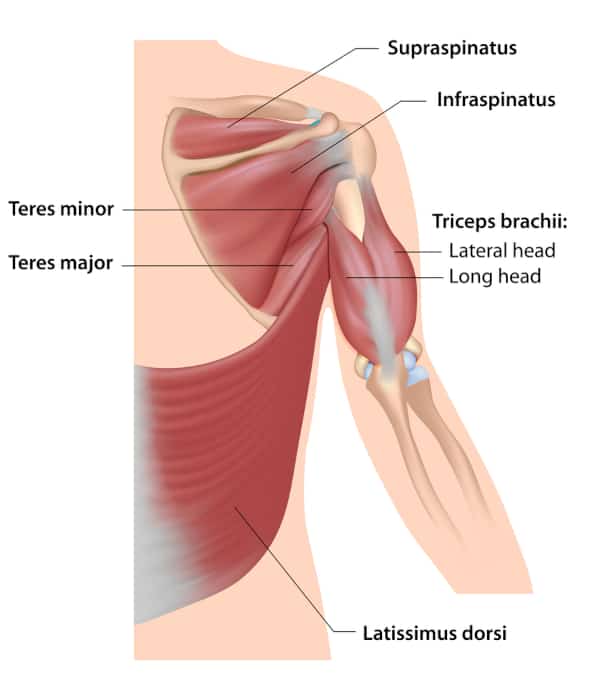Teres major and minor exercises play an important role in shoulder stability and movement. Strengthening the teres major and minor muscles will help improve upper body strength, posture, and overall fitness. The exercises can be performed using a variety of equipment, including dumbbells, resistance bands, and cable machines. They can be particularly beneficial for athletes who participate in sports such as swimming, rock climbing, and tennis. By incorporating teres major and minor exercises into your workout routine you will target these important muscles effectively, reduce risk of injury, and improve the overall upper body function.

Training smaller muscles is often an overlooked part of any exercise routine. Incorporating some teres major exercises into your arm and shoulder routines is a great way to push your limits and build a balanced-looking body. Sculpting an athletic physique takes a lot of hard work and dedication. It is also a lot more complicated than just performing a few different movements and calling it a day. Balance and symmetry are key in weight training, and that means focusing on the smaller things, which not only suffer when neglected but, when trained correctly, help the larger, more prominent muscles do their work even better. Teres major exercises are a prime example of a series of lifts that can really help bring that extra oomph to your workouts.
When most people think about strengthening muscles of the upper body, they think of larger or more familiar muscles (the lats, rhomboids, biceps & triceps, etc.). While the importance of training these muscles is not lost on anybody, it’s also vital that you pay attention to the smaller muscles, such as the teres major and teres minor.
The teres major and teres minor are two muscles in your shoulder that offer much-needed support or rotational flexibility in the joint. Training them is a not-so-often discussed technique for boosting should strength and building real power and muscular definition.
Where are the Teres Major & Teres Minor?
Before we dive into specific teres major and minor exercises, let’s go over what these muscles do and where they’re located.

The teres major runs along the lateral edge of your scapula. It’s known as a synergist (or supporting/stabilizing muscle) for the latissimus dorsi (the large muscle of the back). It’s also responsible for internally rotating and adducting (bringing in toward the midline of the body) the arm.
The teres minor is part of the rotator cuff. It sits below the infraspinatus (another rotator cuff muscle), underneath the deltoid, and above the teres minor. This muscle is responsible for externally rotating the shoulder. It also aids in adducting and extending the shoulder.
What are the benefits of teres major and minor exercises?
Teres major and teres minor exercises play an important role in shoulder stability and movement. They help to improve overall upper body strength, posture, and athletic performance. Below are some of the benefits:
- Improved Shoulder Stability: Teres major and minor exercises can help to improve shoulder stability, which is important for preventing injury and improving overall upper body function.
- Increased Upper Body Strength: By targeting the teres major and minor muscles, as well as the surrounding upper back and shoulder muscles, these exercises can help to improve overall upper body strength.
- Improved Posture: Teres major and minor exercises can help to improve posture by strengthening the upper back muscles and promoting proper alignment of the shoulders and spine.
- Reduced Risk of Injury: Weak teres major and minor muscles can increase the risk of injury to the shoulder joint and upper back. By strengthening these muscles through exercise, individuals can reduce their risk of injury and improve overall joint stability.
- Improved Athletic Performance: Strong teres major and minor muscles are essential for many sports and activities that require upper body strength and stability, such as swimming, rock climbing, and tennis. By incorporating these exercises into their workout routine, athletes can improve their overall performance in their sport.
What are the best teres minor and teres major exercises?
Below are six highly effective teres minor and teres major exercises to add to your shoulder strengthening workouts.
1. Resistance Band Horizontal Rotation

When planning a teres minor workout, be sure to include resistance band horizontal rotations. This exercise does a great job of strengthening the teres minor, as well as the other muscles of the shoulder and rotator cuff.
You can also do this exercise as part of a warm-up before you perform other upper body exercises. By warming up and targeting the teres minor first, you can encourage good shoulder health and proper mechanics when doing more complicated exercises with heavier weights.
To do this exercise, you’ll need a light resistance band. Loop the band around a sturdy surface and make sure it’s level with your shoulder, then grab the other end of the band and follow these cues:
- Take a step back so that you create tension on the band
- Raise your arm so that your shoulder forms a 90-degree angle with your torso and your elbow is also bent at a 90-degree angle (your palm should be facing down)
- Keeping your shoulder and elbow joint fixed at a 90-degree angle, exhale and slowly rotate your upper arm so that your forearm moves down until it’s parallel to the floor
- Raise your arm and return to the start position on an inhale
2. Single-Arm Dumbbell Rows

If you’re interested in doing teres major exercises with dumbbells, the single-arm dumbbell row is an excellent option.
Most people think of this exercise as a lat exercise, and it’s true that it does strengthen this muscle. Remember, though, that the teres major supports the lat, so by performing single-arm rows, you’re also, by default, strengthening this smaller synergistic muscle.
To do this exercise correctly, start by grabbing a light-moderately heavy dumbbell. Grasp it in one hand with your palm facing inward, then hinge at your hips and bend forward to rest your other hand on a bench or box. From here, do the following:
- On a exhale, retract the scapula while keeping your arm straight
- Once the scapula has been retracted, bend your elbow and pull the dumbbell back toward your hip
- Inhale and return to the starting position, protracting your scapula at the end of the exercise to move your shoulder through a full range of motion
3. Seated Single-Arm Row

Another exercise to add to your teres major workout is the seated single-arm row. Because you’re sitting down, you’re able to better isolate the shoulder and upper back during this exercise since you won’t be using your legs or other muscles to help you out as much.
When doing this exercise, start by sitting up straight on the bench of the cable machine, grasping the handle of the cable in one hand with your palm facing inward. From here, follow these cues:
- On an exhale, retract your scapula while keeping your arm straight
- After retracting the scapula, bend the elbow and pull the handle back toward your hip
- Inhale and return to the starting position, making sure to protract your scapula at the end of the exercise
4. Dumbbell Rear Delt Fly

Dumbbell rear delt flyes are another excellent exercise for the teres minor. They help you practice externally rotating your shoulders and improve your overall shoulder range of motion.
When doing this exercise, keep in mind that it’s best to use a light pair of dumbbells. If you use weights that are too heavy, you could end up straining your shoulder joint or relying on other muscles more than the rear delts and teres minor.
Hold a dumbbell in each hand with your palms facing inward. Hinge at the hips, hold the weights in front of you with the arms straight, and then follow these cues:
- Keep the elbows slightly bent and in a locked position
- On an exhale, straighten your arms and open them up to the sides (similar to when you do a chest fly)
- Focus on retracting your shoulders and squeezing them together at the top of the exercise
- Inhale and return to the starting position, protracting your shoulders slightly at the end
5. Face Pulls

Face pulls strengthen the shoulders and rhomboids. They’re also great for the teres minor and infraspinatus muscles.
To do face pulls correctly, start by hooking a rope attachment to a cable machine and adjusting it to shoulder height. Then, do the following:
- Grasp one end of the rope attachment in each hand (palms facing down) and step back from the cable machine to create tension
- On an exhale, bend the elbows and pull the rope back toward your face
- When the attachment gets close to the face, separate your hands on either side of the face so that you don’t hit yourself in the head
- Inhale and return to the starting position
6. Dumbbell Cuban Press

The Cuban press is another effective option for folks looking for teres exercises that they can do with dumbbells. This exercise targets the teres minor, as well as the trapezius muscles and other muscles of the shoulder girdle.
Start with a pair of light-moderately heavy dumbbells. Stand up straight with your feet about shoulder-width apart, a dumbbell in each hand at your sides, and follow these cues:
- Keep the dumbbell in a horizontal position and pull them up toward your shoulders (let your elbows lead, similar to when you do an upright row) as you exhale
- When the upper arms are parallel to the floor, hold them in place and rotate the arms to flip the dumbbells so they’re facing up
- From here, perform a shoulder press and push the weights straight up overhead
- Pause for a second here, then lower the weights back to the starting position as you inhale
Strengthen Your Teres Major & Teres Minor Today
The teres major and teres minor are two important (although often overlooked) muscles that help to support the shoulders and upper back.
By adding teres major and teres minor exercises into your routine, you can strengthen these muscles, improve your performance, and protect your upper body from injuries. Give one (or more) of these exercises a try today to start seeing results. Getting serious about your strength training means educating yourself on the human body. There are more muscles than you’d learn in most non-specialized educational settings, and they all play an important role in how we function. Even by changing your contraction point or the angle of your lift can hit different muscles.
Training with weights is a straightforward endeavor. You take the weight, you apply good form, and you lift the weight along the correct range of motion. Teres major exercises work in the same way. Only they are designed to target smaller muscles that you don’t normally see but play a crucial role in how your arms move and how much weight you can lift.
Try adding some of the above teres minor or teres major exercises into your training routine and see for yourself just how much a few simple additions can push your entire body to new heights.